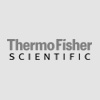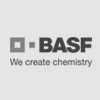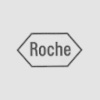Influenza A NCP ELISA (Photometric)
Influenza viruses can be divided into three classes, A, B, and C, largely based upon conserved antigenic differences in the internal nucleoprotein. Influenza A virus, typically encountered more frequently than types B and C, and associated with the majority of serious epidemics, can be further subdivided into strains or subtypes based on antigenic differences in the external hemagglutinin proteins (H1-H16) and neuraminidase proteins (N1-N9).
A variety of wild waterfowl appear to be the predominant natural reservoir for Influenza A viruses and subtypes representing many of the hemagglutinin and neuraminidase combinations can be found circulating in these birds. Historically, human influenza virus infections have been associated with H1N1, H2N2, and H3N2 subtypes of influenza A, although a recent (1997) and significant outbreak in Hong Kong was identified as an H5N1 subtype.
This outbreak was not only significant because it resulted in 18 human infections and 6 deaths, but it also represented the first known demonstration of avian influenza virus transmission to humans. Since the 1997 H5N1 outbreak in Hong Kong, additional outbreaks of different influenza A subtypes exhibiting bird to human transmission have been documented; H9N2 in Hong Kong (1999, 2003) and China (1999), H7N2 in The Netherlands (2003), and H5N1 in China (2003) and Southeast Asia (2003-2004). As a result of these outbreaks and other information, there is a significant concern that a human pandemic strain of influenza A could emerge.
|
|
While Influenza A subtype identification is extremely important (vaccine production, epidemiology), the rapid and accurate differentiation of influenza A from influenza B and C and other respiratory agents in humans and animals is also important (treatment and biosecurity). Virusys has developed a highly sensitive and specific enzyme immunoassay for the detection of Influenza A nucleoprotein antigen in complex sample matrices derived from both human and veterinary sources. The assay can be completed in less than 1.5 hr. and contains only one wash step.
The detection limit of the kit varies depending upon the type of sample being evaluated. In assays using recombinant antigen, purified virus, virus in tissue culture fluid or diluted in a "simple" buffer (PBS/BSA), the analytical sensitivity is ~150 pg/ml.
See how it compares to other assays here:
CVS 2012 Poster-Comparison of 11 FDA Approved RIDTs.pdf
Download the instructions below:
The Virusys Influenza A Nucleoprotein Antigen Detection ELISA also incorporates proprietary diluents that are designed to prevent the development of nonspecific signal derived from complex sample matrix effects or the nonspecific adsorption of reactive test components resulting in both high sensitivity and specificity (Figures 1-5). The test kit is available in a standard photometric format that utilizes TMB (3,3',5,5'-tetramethylbenzidine), a highly sensitive, photometric horseradish peroxidase (HRP) substrate (Figure 1) or in an HRP-based chemiluminescent format for enhanced sensitivity (Figure 2). Influenza A subtype sensitivity is demonstrated in Figure 5. The efficacy of the proprietary Virusys diluent can be seen in Figures 3 and 4. In Figure 3, a variety of poultry samples (tracheal and cloacal swabs, tissue homogenates, litter samples, and allantoic samples) were tested using a standard diluent and the kit diluent. The results clearly show the benefit of the kit diluent. Likewise, a series of tracheal and cloacal swabs from noninfected chickens were tested (Figure 4) and the nonspecific activity associated with these types of samples was eliminated as well. Additional specificity testing was performed using high titers of the following potentially interfering or cross-reactive agents and no reactivity was detected:
Infectious Bronchitis Virus (Beaudette)
Infectious Bursal Disease Virus (2512)
Infectious Laryngotracheitis Virus (Cover)
Newcastle Disease Virus (LaSota)
Influenza B
Respiratory Syncytial Virus
Parainfluenza Virus, Type 1
Parainfluenza Virus, Type 2
Parainfluenza Virus, Type 3
E. coli
S. typhimurium
C. jejuni
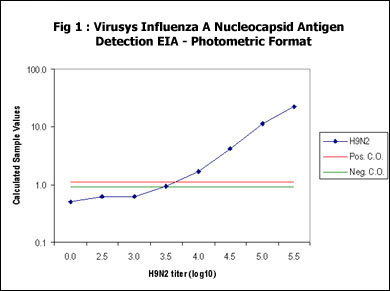 |
Figure 1: Photometric format
Serial dilutions of Influenza A, subtype H9N2, were tested in the photometric version of the Virusys Influenza A Nucleoprotein Antigen Detection ELISA. Absorbance values were converted to Calculated Sample Values according to the product insert, and plotted against virus titer dilutions (EID50/ml or Egg Infectious Dose/ml). The equivocal zone of the test is delineated by the Positive and Negative Cut-off values. In this assay, 10,000 EID50/ml of H9N2 were easily detected.
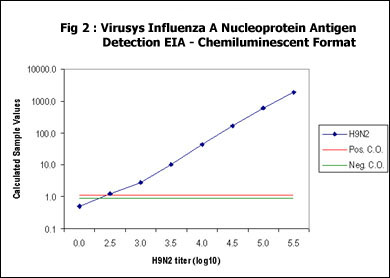 |
Figure 2: Chemiluminescent format
Serial dilutions of Influenza A, subtype H9N2, were tested in the photometric version of the Virusys Influenza A Nucleoprotein Antigen Detection ELISA. Absorbance values were converted to Calculated Sample Values according to the product insert, and plotted against virus titer dilutions (EID50/ml or Egg Infectious Dose/ml). The equivocal zone of the test is delineated by the Positive and Negative Cut-off values. In this assay, 300 EID50/ml of H9N2 could be detected.
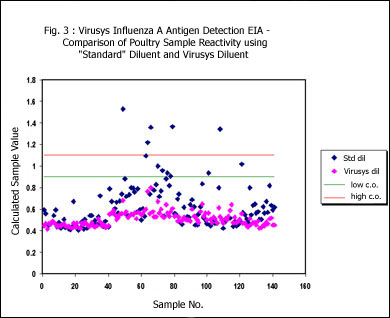 |
Figure 3: Photometric format
One hundred and forty-six samples from a regional poultry laboratory were first tested by embryonated egg inoculation and found to be negative for Influenza A. These samples were retested in the Virusys Influenza A Nucleoprotein Antigen Detection ELISA with and without the proprietary Virusys Diluent. The results clearly illustrate the improved specificity of the assay using the Virusys Diluent.
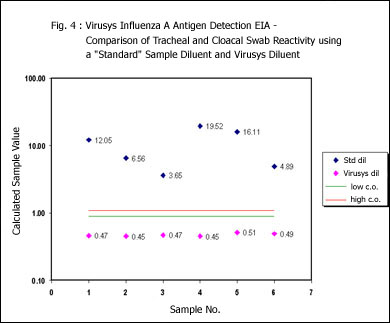 |
Figure 4: Photometric format
Twenty tracheal and cloacal swabs were taken from pathogen-free chickens and evaluated for reactivity with and without the proprietary Virusys diluent in the Virusys Influenza A Nucleoprotein Antigen Detection ELISA. Six of the 40 samples demonstrated high levels of reactivity in the standard diluent, but this reactivity was eliminated using the Virusys diluent.
|
Subtype |
Designation |
ELISA Result |
|
|
|
|
|
H1N1 |
A/Sw/Iowa/31 |
Reactive |
|
H2N3 |
A/Mal/Al/77 |
Reactive |
|
H2N9 |
A/Pintail/Alb/293/77 |
Reactive |
|
H3N2 |
A/Ty/Eng/69 |
Reactive |
|
H3N8 |
A/Dk/Ukraine/1/63* |
Reactive |
|
H4N6 |
A/Dk/Czech/56* |
Reactive |
|
H4N8 |
A/Parrot/Eng/70 |
Reactive |
|
H5N1 |
A/Ck/Scot/59 |
Reactive |
|
H5N2 |
A/Quail/Ore/20719/86 |
Reactive |
|
H5N2 |
A/Ck/Wa/13413/84 |
Reactive |
|
H5N2 |
A/Ck/Penn/13701/83 |
Reactive |
|
H5N2 |
A/Ty/Min/3689-1551/81 |
Reactive |
|
H5N3 |
A/Ty/CA/35621/84 |
Reactive |
|
H5N3 |
A/Tern/SA/61* |
Reactive |
|
H5N8 |
A/Ty/Ireland/83 |
Reactive |
|
H5N9 |
A/Ty/Wis/68 |
Reactive |
|
H5N9 |
A/Ty/Ont/7732/66 |
Reactive |
|
H5N2 |
A/Ck/Que/14588-19 (Mex. Isolate) |
Reactive |
|
H5N2 |
A/Ck/Hidalgo/26654-1368/94 (Mex. Isolate) |
Reactive |
|
H5N2 |
A/Ck/Pue/8623-607 (Mex. Isolate) |
Reactive |
|
H5N? |
A/Emu/Tx/39924/93 |
Reactive |
|
H5N3 |
A/Emu/Tx/39924/93 (IB clone E2) |
Reactive |
|
H6N2 |
Field isolate, Cnn00053 |
Reactive |
|
H6N8 |
A/Ty/Ont/63 |
Reactive |
|
H7N2 |
A/Ty/Ore/71 |
Reactive |
|
H7N3 |
A/Ck/Aust/3634/92 |
Reactive |
|
H7N3 |
A/Ty/MN/29206/83 |
Reactive |
|
H7N7 |
A/Ck/Vic/32972/85 |
Reactive |
|
H7N8 |
A/Magrob/China/28710/93 |
Reactive |
|
H7N9 |
A/Ty/MN/38429/88 |
Reactive |
|
H8N4 |
A/Ty/Ont/61181/67* |
Reactive |
|
H9N2 |
A/Ty/MN/12877/1285/81 |
Reactive |
|
H9N2 |
A/Ty/Wis/1/66* |
Reactive |
|
H9N9 |
A/Pheasant/Wa/37 |
Reactive |
|
H10N7 |
A/Ck/Germany/49* |
Reactive |
|
H10N8 |
A/Quail/Ithaca/1117/65 |
Reactive |
|
H11N1 |
A/Dk/Eng/56* |
Reactive |
|
H11N9 |
A/Dk/Memphis/546/74 |
Reactive |
|
H12N1 |
A/Dk/Alberta/60/76* |
Reactive |
|
H13N1 |
A/Gull/MD/704/77* |
Reactive |
|
H14N5 |
A/Mal/Gurjev/263/82* |
Reactive |



